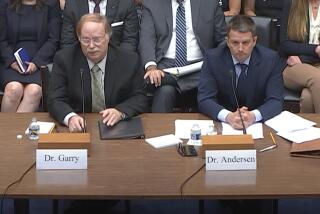New data mined from historic ‘primordial soup’ study
- Share via
A historic 1953 experiment in which a chemist created a “primordial soup” of organic molecules — showing that the chemical building blocks of life could have originated on a hot, gassy Earth — was even more remarkable than scientists back then realized.
Half a century later, researchers have unearthed a trove of long-lost experiments conducted by U.S. chemist Stanley Miller in his classic work. Using modern technology to analyze one key experiment, they have discovered that Miller’s attempts produced more organic compounds than even he realized.
The study, published online Monday in the journal Proceedings of the National Academy of Sciences, sheds light on Miller’s work — and shows how early-Earth volcanoes could have been a breeding ground for organic compounds.
Miller set up the experiment with chemist Harold Urey while at the University of Chicago. The original demonstration involved a globular glass container filled with hydrogen, water, methane and ammonia — gases he thought made up the atmosphere of Earth around 4 billion years ago, before the evolution of life. Two electrodes generated a spark, simulating lightning striking through the swirling gases, providing the energy for the gases to recombine into organic compounds called amino acids, the building blocks that make up proteins as well as some sugars.
“It’s one of the real exciting success stories for origin-of-life research,” said Robert Hazen, an astrobiologist at the Carnegie Institution for Science in Washington, D.C., who was not involved in the study.
What nobody knew was that Miller continued to conduct primordial-soup studies for years, amassing hundreds of vials representing perhaps 50 experiments, said study coauthor Jeffrey Bada, a cosmogeochemist at the Scripps Institution of Oceanography at UC San Diego, who was one of Miller’s students.
“Unbeknownst to me, he’d saved all the original extracts of experiments he’d constructed in the ‘50s, and when I found this out, I was dumbstruck,” Bada said.
Bada, who inherited Miller’s lab materials after the famed chemist passed away in 2007, came across the samples in a dusty cardboard box. Among the old vials he found the remnants of a particularly interesting experiment conducted in 1958 — one that tested a gaseous mix rich in hydrogen sulfide, the pungent compound responsible for the rotten-egg odor emitted by volcanoes.
Bada and his colleagues decided to test the forgotten samples using modern equipment. Miller had used an analysis technique called paper chromatography — a crude technique by today’s standards. Chemicals would be detected only if they were present in tenths of grams, and each sample took days to be analyzed.
Today’s high-performance liquid chromatography coupled with mass spectrometry takes minutes, Bada said, and the technology is 100,000 to a million times more sensitive.
Miller discovered five amino acids in his original 1953 experiment. But after running new tests of his 1958 samples, the team found — to their astonishment — 23 amino acids.
The hydrogen-sulfide-laced gases Miller used to create these amino acids didn’t represent the atmosphere of ancient Earth as a whole, but it did resemble the air that would have existed around volcanoes that covered the globe at the time, Bada said — suggesting that these noxious, smelly environments might have been just the ticket for spawning the molecules of life.
The researchers also compared the hydrogen sulfide mixture to the composition of meteorites that have struck Earth, and found that the proportions of amino acids were similar. Thus, they argued, the building blocks of life could also have originated elsewhere. The research was supported by NASA’s Astrobiology Institute in Mountain View and Goddard Center for Astrobiology in Greenbelt, Md., which are focused on how life may have developed in the universe.
Why didn’t Miller ever fully analyze and publish his results? Bada and Hazen suspect that the task was too cumbersome with the analytic tools Miller had at his disposal.
Miller said he hated working with hydrogen sulfide, Bada added.
“It’s very smelly,” Hazen explained. “Just a trace of it will make your lab absolutely uninhabitable — and make you enemies up and down the hall for months.”
More to Read
Sign up for The Wild
We’ll help you find the best places to hike, bike and run, as well as the perfect silent spots for meditation and yoga.
You may occasionally receive promotional content from the Los Angeles Times.










